Stories
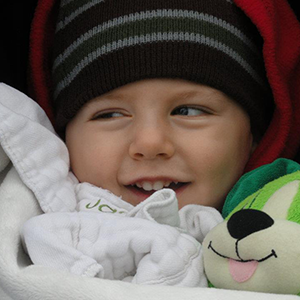
Jack’s Story
Jack’s story started like so many others. In those happy, hazy hours after their first baby was born, Mike and Liz Pribaz were your typical over-the-moon new parents. They marveled at their beautiful son, Jack Wyatt, who arrived with a full head of hair. At Central DuPage Hospital in Winfield, Illinois, they began learning all about their boy: who he most resembled (Liz), how to change his diaper (which scared Mike a bit), and how light and easy eight pounds, six ounces of pure joy could be to hold in their arms. It was the morning of March 5, 2009.
But by 4 am a nurse noticed something wrong. After consulting with the NICU doctor, she woke Mike and Liz with frightening news. “Jack seems to be having seizures,” she told them, and from that moment forward, Jack’s story changed forever.
Tests, tests, and more tests
The 17-hour-old was taken to the NICU, and the tests began: blood work, spinal tap, CAT scan, MRI. They put leads on his scalp and hooked him up for an EEG, but his brain wasn’t giving up any secrets just then. All his other tests came back normal. Mike and Liz steadied themselves with statistics that sometimes babies are born with unexplained seizures that disappear on their own after a few weeks or months. Everything else about Jack seemed healthy and normal. Doctors started Jack on anti-seizure medicines and sent him home.
But the seizures didn’t disappear. Before March was over, increasing seizure activity caused Mike and Liz to bring Jack to Children’s Memorial Hospital in Chicago. New EEG tests there revealed devastating news: Jack’s baseline brain activity was severely abnormal. Jack, they were told, might not make it to his first birthday. Doctors took samples of Jack’s blood to send to laboratories across the globe; it would be tested for the rarest genetic and metabolic disorders. They would have no real answers for several months, and they warned Mike and Liz that there might never be a diagnosis. This concept—to have to live with the unknown—was one of the hardest things for the new parents to process: how do you plan for a future you cannot imagine?
Jack’s case was placed under the wide umbrella called “epilepsy,” and Mike and Liz learned the staggering statistic that up to half of all epilepsy cases don’t have a known cause or defined underlying condition. Besides a series of standard anti-seizure medications, doctors offered two treatments for Jack to try: a ketogenic diet—which for an infant would require a special low-carbohydrate formula; and injections of an incredibly expensive and experimental drug called ACTH. Mike and Liz accepted both options and took Jack home, along with a lengthy and complicated set of instructions for his care. The new dad who had been squeamish about a poopy diaper was now giving his son daily injections. But Mike and Liz—and Jack Wyatt, whose middle name means “brave, strong warrior,” would take on the fight, even though at this point in Jack’s story they didn’t yet know what enemy they were battling.
Raising an Army
The injections and diet seemed to be successful in controlling Jack’s seizures, and repeat EEG test showed that the electrical activity in Jack’s brain had changed dramatically for the better. These encouraging developments took a great strain off Mike and Liz.
As Jack began spending more time at home than in hospitals, some semblance of a normal life started to emerge. His parents got used to all their special tasks. At three months they enrolled Jack in the Illinois Early Intervention Program to make sure he was getting all the support available. And Jack celebrated his first birthday with a big party and special low-carb ketogenic cake Liz made.
However, as the threat of seizures seemed to decrease, it became increasingly obvious that Jack was not developing normally. He missed milestone after milestone. Mike and Liz, and all their family, struggled to stay positive.
A supportive network of family and friends continued to grow around Mike and Liz. Liz’s sister Anna quit her job to help with Jack. Grandparents, aunts, uncles, and cousins helped however they could. Mike, a history teacher and coach at Wheaton North High School, received an outpouring of support from friends and fellow teachers. No one wanted to feel helpless; everyone wished they could do something.
So that spring, Mike and Liz signed up to do their first Epilepsy Foundation Walk in Wheaton. They chose the name Jack’s Army. Friends and family volunteered in numbers to rival the wave of conscripts that followed Pearl Harbor. Uniformed in camouflage t-shirts on a cold May morning, Jack’s Army began its determined march forward.
Growth, redefined
Fast-forward more than two years. All the known tests for rare conditions had come back negative, which is always a good news–bad news proposition; as each clean test took a bad diagnosis off the table, the trail to find answers grew a bit colder.
Mike and Liz learned to take one day at a time and celebrate small successes. Jack continues to grow, as did his signature blond hair, which Liz likes to keep in a handsome, no-nonsense buzz cut. He has a killer smile that his family frequently sees. The brave, strong warrior is working hard with therapists of all stripes. And in ways that are bittersweet but nothing short of miraculous, he has taught everyone who knows him that they are stronger and have a greater capacity for love than they ever knew possible.
Jack welcomed a new brother, Matthew Presto Pribaz, born on November 18, 2010. He is a healthy boy (and Mike and Liz thought they were tired before Matt came along!). Matt has added a happy new chapter in the family story.
But Matt wasn’t much older than two or three months before he started to surpass his older brother in developmental milestones. At two-and-a-half years old, Jack continued to suffer from low muscle tone—a condition that prevents him from controlling his own head or sitting unassisted. In November 2011 he required surgery to place a g-tube, or feeding tube, to help him get his nutrition. Jack cannot speak. What his cognitive ability or prognosis are remain a mystery. In addition, Jack suffers from what his doctors call “startles,” tiny spasms that last less than a second but come on repeatedly when Jack tries to fall asleep. This condition, while harmless, lead to an overall loss of sleep for the entire family, because when Jack cannot sleep he often cries inconsolably. Melatonin helps him to relax sometimes, but not always.
It has been terribly frustrating for Mike and Liz not to know what Jack is experiencing, feeling, or thinking. But they have chosen to stay positive. They read to him, talk to him, play with him. Jack has a favorite book and stuffed animal, the trusty green dog Scout. Mike and Liz understand Jack has limited ability to respond, but no one knows what he might be taking in. And no one really knows what the future holds—an uncertainty once maddening that now makes room for hope.
The KCNQ2 breakthrough!
In July of 2011, doctors at CMH learned of a newly available genetic test. Jack seemed like a good candidate, and so another vial of his blood was tested. Mike and Liz were by now used to tests being sent off without any answers returning. It was a huge surprise in August, then, when the result came back positive. Jack’s had a rare genetic mutation of the gene called KCNQ2.
Mike and Liz were immediately tested themselves. Neither had the mutation. This meant that Jack had not “inherited” this condition. Jack’s doctors pointed out that knowledge of this mutation was just in its earliest stages. Researchers believe that this gene regulates potassium channels (which are instrumental in muscle control). Mike and Liz were told about a newly approved drug, Potiga, that might help Jack. They waited impatiently for the drug to come to market.
The Jack Pribaz Foundation
As soon as they had a name—KCNQ2—to focus on, Mike and Liz started searching for any information they could find. The trouble is that there wasn’t much research published yet, at least not for a lay person to digest. The field was too new.
Although novel (or “de novo”) mutations of KCNQ2, like Jack’s condition, are rare (Jack was one of a handful of known cases), researchers think more patients will be discovered as the testing becomes more readily available. They are interested in studying KCNQ2 for the secrets it might unlock about the mechanisms at work in epilepsy more broadly.
So while Mike and Liz waited for the new drug, they moved into action mode. Overwhelmed by the generous support of people who know Jack’s story and enlisted to help, they established the Jack Pribaz Foundation to assist researchers in learning all they can about KCNQ2 encephalopathy.
And Jack Wyatt, who doctors at one time worried would not see his first birthday, turned three on March 5, 2012. He attended a special preschool the very next day.
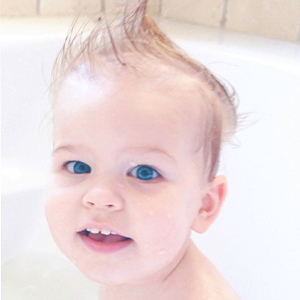
Harper’s Story
On May 2, 2011 Harper was born at Rose Hospital in Denver, Colorado. Initially Harper seemed to be in perfect health, although she was unusually quiet. When Harper was two days old, we noticed her first tonic-clonic seizure. She was moved to the NICU at Rose Hospital for several days then transported by Flight for Life to Rocky Mountain Children’s Hospital in Aurora, Colorado.
At Children’s, Harper underwent many tests including EEGs, MRIs and various genetic tests. Harper’s EEG was abnormal and showed a “burst and suppression” pattern and hypsarrhythmia (spasms). Harper was initially diagnosed with Ohtahara Syndrome and we were told that she would likely not survive long enough to leave the hospital. Harper was christened at Children’s Hospital on May 15, 2011.
Fortunately, the Ohtahara diagnosis was incorrect. Harper was discharged from Children’s Hospital on May 23, 2011. At the time of her discharge Harper was taking Kepra, Topomax and Phenobarbital and having 10-15 tonic-clonic seizures a day. She was heavily sedated by these medications, slept most of the day and night, and feeding was extremely difficult. Harper began receiving ACTH injections twice per day on June 2, 2011 and had her last seizure on June 5, 2011. Harper has been seizure free since that time. Over the next few months, Harper was weaned off all seizure drugs and her EEGs became gradually improved. In December, 2011 Harper had a “normal” EEG. We were ecstatic.
Meanwhile, in August, 2011 we learned that Harper has the KCNQ2 genetic mutation. Since that time, we have been focused on learning as much as we can about KCNQ2 and helping Harper meet her milestones. Harper has been receiving physical therapy, speech therapy and occupation therapy in our home regularly since soon after she was discharged from Children’s. Although she is delayed, we are thrilled with her progress. At two and a half, Harper now walks with a walker, can say a few words, sits up and crawls on her own, utilizes some sign language and is very expressive. Feeding, sleeping and temper tantrums remain a problem. Although we have tried, we have been unable to establish any type of normal “schedule” with Harper. She tends to alternate between sleeping excessively and not sleeping at all.
Harper began taking Potiga in August, 2012 to help meet her milestones. Much of Harper’s progress occurred after starting Potiga. Harper’s doctor is unsure if this progress is linked to the Potiga or if it is her natural progression. We recently learned of some potentially harmful side effects of Potiga and will be weaning Harper off of the medication over the next several weeks. I will keep you all updated of her status.
Harper’s older brother, Aidan, nicknamed Harper “Nezbah” before she was born. We later learned that Nezbah is a Navajo work meaning “woman in battle.” Thank you to Mike, Liz and everyone at Jack’s Army for fighting this battle with us and on behalf of all of our children.
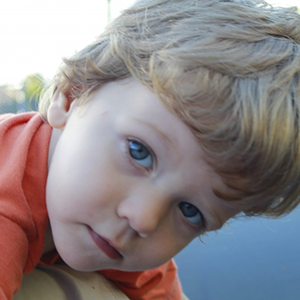
Oliver’s Story
Oliver was born in February 2012 through an elective caesarean section. On day 2 of life, while he was breast feeding, Oliver broke attachment and started staring and all 4 limbs were twitching. The next day, he had 2 tonic clonic seizures lasting about 45 secs each time. He was then transferred into the hospital’s special care nursery. There he had numerous tests including a lumbar puncture, MRI, ultrasounds and many blood tests. All of these tests came back normal. A week later, he was transferred to a larger hospital for extensive and specialised testing, including a few EEG’s.
Over the next couple of months he had numerous hospital admissions due to increase seizure activities and the inability of his medications to keep up with them. After his scheduled 4 month vaccinations, he had his longest seizures to date. A 7min seizure at home, an 8 min seizure at hospital, then had a 45min status and transferred to the Intensive Care Unit. It was after that enormous seizure that his neurologist decided to do genetic testing. After a couple of days, he was fine and sent home.
Over the next 4-6 months, his hospital admissions due to seizure activity were getting less. However, he was not putting on any weight, his appetite decreased and it got to a stage where his output was getting less and less. His doctor decided to do some blood tests. His electrolytes were at a critical level and with consultation with a metabolic doctor, decided it was his current anti-epileptic drug was the root cause of this. We changed medications immediately.
In July, 2013, we discovered that Oliver was diagnosed with the KCNQ2 gene mutation, the cause of his epilepsy. Through the internet, we have discovered many families that are affected by this and have been a tower of strength for all of us.
At 22 months of age, he had been seizure free for 10 months and is physically growing well. Developmentally he is quite behind children of a similar age. He started walking at 19 months of age. Still quite non-verbal, and it is like he is in his own little world. He has had a recent diagnosis of Autism, fortunately, he is on the lower end of the spectrum. He receives regular physical therapies through Occupational Therapists, Physiotherapists and Speech Pathologists.Because there isn’t much known about KCNQ2, the doctors are learning as we are learning. We continue to support his needs and whatever he requires. We take it day by day and try to live life as best we can.
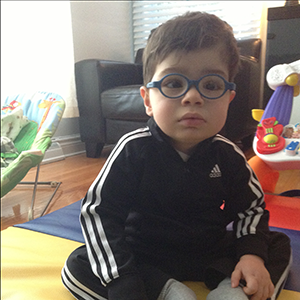
Michael’s Story
On the night of February 5, 2012, our beautiful little boy Michael was born at St Mary’s Hospital in Montreal. We spent the first couple of hours all cuddled up, amazed at how big he was (9.2 pounds) and trying to figure out who he got those beautiful blue/gray eyes from. With 4 year old big sister Olivia at home, our family was complete.
12 hours later the nurses noticed that something was wrong and rushed Michael to oxygen. Michael had his first seizure….
In the hours, days and months that followed, we met with every specialist at the Montreal Children’s Hospital. Michael was tested for practically every condition that causes seizures and everything came back negative. His MRI was normal, we had no history of seizures in the family, but Michael continued to have seizures. He was loaded with many anti-epileptic drugs but none seemed to get control of the seizures. The next drug in line was Dilantin. Luckily, Michael reacted well to it and has had better seizure control since (with occasional hiccups here and there). Though the seizures seem to be better controlled we know that Michael’s battle is not nearly over. Michael has made some significant progress but is not developing at the rate of a regular 3 month old.
On the day we were being discharged from the hospital, our Neurologist said that one of the tests came back positive and she needed to discuss it with us. Like Jack, they discovered a mutation in his KCNQ2 gene. We did not know what this meant and what Michael’s development would be like. We were crushed and desperately in need to talk to someone who knew what all this meant.
We could not have done it without you!!!!!
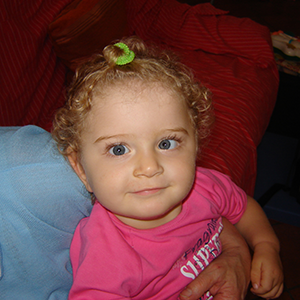
Chiara’s Story
Chiara was born on 13th January 2011 by natural childbirth at 38 weeks, she is my second daughter (her sister is 5 years old) and the pregnancy was normal.
The first two days of her life passed without problems, Chiara also started to breast-feed, but the third day the nightmare began.
It was not possible to wake up the baby even by washing her in water and the doctors suggested to move her to intensive therapy ward where she stayed for 2 months.
At that time she had about 20- 30 crisis a day and they used a gastic nasal tube to feed her, they made a NMR (Nucler Magnetic Resonance), a lumbar puncture, many exams for metabolic diseases and some genetic exams, all with no results.
We were sent home without an explanation and we were told that if crises had not pass, she would not survive more than 3 years.
At home the number of crisis decreased and she learnt to eat with baby feeding bottle, but after a calm period, crises started again even stronger and MICROPAN was not enough any more, so I had to bring her to hospital where every time they gave her cortisone.
I contacted many hospitals but all of them just told me all possible exams have been already made and that many forms of epilepsy have an unknown cause. I made another try contacting the hospital of Florence where she stayed 3 times making other genetic and metabolic exams, other 2 NMR, all without any results, but they told me about a possible MITOCHONDRIAL disease.
In June the asked for some blood samples of Chiara, me and my husband and in October they told us she has KCNQ2 gene mutation, but it was not found in my husband and me, only Chiara has it.
At present we give Chiara Tegretol but we are slowly trying to decrease it, since now crises are fewer (3 or 4 each month).
Chiara can control her head, but she can’t remain sit and she can’t roll over.
She must eat everything whipped, she can recognise people, she catch things and take them to her mouth.
She cries often and it takes her a long time to fall asleep.
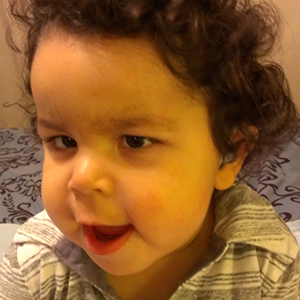
Liam’s Story
Liam Alexander Tricoche was born May 21, 2010 at Columbus Regional Medical Center in Columbus, GA. His birth was and uneventful scheduled, repeat c-section. He was the picture of health weighing in at 8lbs 5oz and measuring 19 3/4 inches long.
Liam began having seizures several hours after being born. After having his seizures observed he was moved to the a Special Care Unit where an MRI was done and a Spinal Tap was performed. All results were normal and after his MRI he began to desaturate during his seizures. For closer observation he was moved to the Neonatal Intensive Care Unit where a Phenobarbital regimen was started. After 18 days of pushing the dosage of Phenobarbital higher and higher, preforming test after test with no answers or clues as to the cause of the seizures, Liam was transported to Children’s Healthcare of Atlanta at Scottish Rite. He was placed in the Pediatric Intensive Care Unit where we were able to meet with a Pediatric Neurologist. After another EEG and MRI, the doctor decided to start Liam on Keppra which she felt would better control the seizure activity. After 11 days in the hospital there Liam was released to go home. He was still having seizures and we were slowly increasing the new medication and decreasing the old.
Since then Liam has been hospitalized once for a seizure cluster lasting longer than 30 minutes. Liam’s last known seizure was April 25, 2011 which caused us to change the anti-seizure medication to Trileptal. Since then, he has not suffered another seizure. Liam has hypotonia, mild strabismus, pervasive developmental delay and has always suffered from reflux. Liam receives Physical Therapy, Occupational Therapy and Speech Therapy on a weekly basis. He is unable to walk or talk and is completely dependent upon someone else to take care of his needs. He is essentially still a newborn trapped in a two year old’s body. July 15, 2011 Liam had a muscle biopsy and was later diagnosed with Mitochondrial Disease based upon biopsy results. We then began additional medications for the diagnosis, one of which was not covered by insurance.
After almost a year with this diagnosis we began seeing another specialist in Mitochondrial and Metabolic disorders. At this appointment she explained that she would like to run testing to dig deeper and possibly find out where the Mitochondrial gene mutation was occurring. The new specialist also wanted to test for any false positives in the original Mitochondrial Disorder diagnosis result. We agreed to the testing and had it done straight away due to the delay in results. After a few months we got an unexpected result on the epilepsy panel. It showed that he has a KCNQ2 gene mutation and that his Mito diagnosis may be a false positive.
We’ve grown used to the feeling of perpetual mystery and helplessness. Liam, who has been pricked and prodded and probed more times than we care to count, seems to take everything well and though he is not developing as we might have hoped, he remains a symbol of love and hope and the reason why families and society at large must defend the defenseless and work tirelessly in the pursuit of scientific discoveries which may force these types of dreadful mutations to disappear from the genome.

Ava’s Story
Ava arrived by natural childbirth at 38 weeks on April 9, 2007. Born a seemingly healthy 7lb 4oz baby girl and scoring nines on her Apgar screenings, we quickly settled into the joy of our newest family member.
During her first day of life all seemed fine, until we noticed a stiffening motion course through her tiny body. The day nurse assured us it was infant gas. Ava was our second child, and we were eager to get her home and start our new family of four. By the grace of God, discharge paperwork was slow to be completed, so we had to stay an extra night in the hospital. It was that night that Ava’s night nurse noticed her stretching movements, and at 4 AM, entered my room to tell me they had placed her in the NICU for clinically diagnosed seizures. My world stopped and all focus shifted to finding strength to manage care for my little girl, whom just hours earlier I had kissed for the first time.
After a few tests, we were given the option to send our baby girl to Texas Children’s Hospital in Houston, TX. We graciously accepted, and our two-hour drive behind the ambulance is one I will never forget. The transport team was amazing, and we knew we had made the right decision.
Upon arrival at TX Children’s, the on-call NICU III neonatologist was not as convinced there was anything wrong with our child and said she “looked too healthy to be here.” After capturing her seizures via EEG, he accepted the fact our daughter was not well. By this time, she was having multiple seizures every hour, but they did not fit the standard patterns of other neonatal seizure disorders they were accustomed to treating. Numerous diagnostic tests were run, including MRIs, EEGs, spinal taps, and genetic and metabolic tests. The doctors could not find a physical cause for Ava’s seizing. There was nothing more they could do for her and she was thriving, so we were sent home after a month’s stay. While Ava’s seizures decreased with medications, they were still occurring multiple times a day.
We started occupational therapy immediately. Physical therapy and speech therapy (for feeding) were soon to follow. Before turning one year old, Ava had good seizure control with a single medication, Trileptal. Even once the seizures were controlled, Ava would continue to develop at a very slow pace. Our monthly specialist visits included neurologist, ophthalmologist, genetics, ENT, and developmental pediatrician.
Despite years of repeat testing, we could not find answers for why Ava was not reaching her developmental milestones. With the help of her continued therapies, she eventually would walk independently (age 3) and speak her needs (age 6). At 7 years old, she still struggles with intellectual disabilities, low muscle tone, weakness, vision impairment, sensory processing, and coordination to name a few. One area our girl has ALWAYS excelled would be her sweet, happy disposition towards life.
After taking a two-year break from searching for answers, we decided to pursue the Whole Exome Sequencing test being offered by Baylor Medical via TX Children’s Genetics clinic in 2013. It was a six month wait for results with only 25% chance of finding a diagnosis. We were beyond words when Ava was diagnosed with KCNQ2 Encephalopathy just shy of her 7th birthday. Her geneticist told us this was a fairly new genetic development and a match that would not have been relatable to her clinical symptoms just a few years earlier. While it does not change how we serve her needs, it does mean hope for future treatments to improve the quality of life for all who strive to overcome this disorder. I am so very proud of my girl and her accomplishments to date.
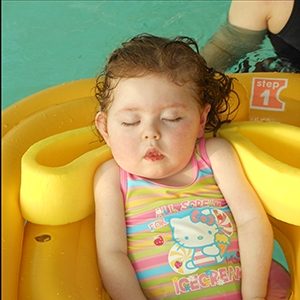
Kirsty’s Story
Kirsty was born on 21st February 2010 at exactly 41 weeks after a normal pregnancy and very easy delivery, Andrew and I were delighted to have what we thought was another gorgeous healthy baby daughter joining her big sister Heather who was 21 months at the time, however all that changed in the first 48 hours.
I first saw her having what we now know was a seizure when she was less than an hour old but realise that’s what it was and started telling everyone she had arrived and all was great. During my one night stay in hospital with Kirsty I became very aware that she wasn’t waking up to feed and when she did wake it was with a scream then within a minute or so she was sound asleep again. The next day we were desperate to get her home with her big sister completely unaware of what was about to happen.
Over the course of the first day and night we both began to think something wasn’t right as Kirsty still wasn’t feeding I was having to express into a cup and pour it into her mouth which she still wasn’t taking and she was excessively sleepy apart from that night where she’d have horrible screaming fits to the point we both ended up sleeping with her on our chest for hours as it was the only way to calm her. It was during one of these that Andrew thought she was having a seizure but shook it off as he just thought he was tired. It was only once she was in hospital that he told me this.
Along with the excessive sleepiness and not feeding Kirsty had started to have lots of jittery movements of her hands, arms and limbs. I remember commenting to my neighbour when she did it, “look that’s the odd movement Kirsty has been doing” but she shrugged it off as Kirsty wanting to look at the light from the window. At 12pm on Tuesday when Kirsty was just over 48 hours old a midwife did a home visit and Kirsty had dropped 10% of her birth weight (something that would normally send a baby back to hospital until feeding was established but it wasn’t mentioned). We told her about the constant sleeping, her odd movements and not feeding but she told us Kirsty was a completely healthy baby and she would visit again on Thursday. She did ask if I had a lot of drugs during labour as baby’s who were normally this sleepy it was because they were still recovering from that. I think it was that comment that really made me think that there was something wrong with Kirsty.
When the midwife left I asked my Andrew who is a Doctor what he would do if a parent came into his surgery with a baby who had Kirsty’s symptoms and he said he’d send them to hospital to be reassured so we took Kirsty to Glasgow’s Yorkhill Children’s Hospital. Any baby under 10 days old should go back to the hospital where they were born but Andrew said to cut out the middle man and go straight to the specialist children’s hospital. On route I kept trying to convince myself that Kirsty just needed fluid to help wake her up and then everything would be fine.
We took her to A&E and she was monitored in triage room and she did her odd movements there and within minutes she was taken straight to the resuscitation room. The registrar on call went to get the consultant and it was there that I saw the word ‘seizure’ on her notes and I became hysterical asking Andrew what that meant and if she was going to die and he of course assured me she wouldn’t but that that she might have had a brain haemorrhage or meningitis.
After lots of tests (lumber punctures, bloods and her first EEG a couple hours later we received the news that Kirsty’s brain was showing a Burst Suppression pattern and that she had a rare metabolic disorder, we were then told when she was 4 weeks old that it was Ohtahara Syndrome. That first night in hospital we were also told that Kirsty would die from this condition. We were even told to take her home over the weekend to get some memories with her sister as they thought she would pass within days.
However this did not happen and Kirsty has proved them all wrong by recently celebrating her 3rd Birthday in February. She has had some scary moments when we have thought we were going to lose her but she’s our tough little princess, who is absolutely amazing and a joy to be around. Since getting grommets in March 2011 her hearing has dramatically improved and she is beginning to recognise our voices and has started smiling and making lots of vocalisations to show she is happy or unhappy. She is now at nursery which she loves and gets to do things like taking part in a Christmas concert so even though she isn’t doing the usual milestones we expect when we have children we focus on new ones. Developmentally she is still around the newborn stage as most of her movements appear to be spasms or small tonic seizures. We are very thankfully that she stopped having the 3 minute Clonic Tonic seizures in May 2011 although not sure why as the medication she is on has remained the same. Those were the ones that were horrible to watch and they caused so much pain. Kirsty’s main issue since March 2011 has been her chest she is often on oxygen and has recently started dropping her sats dramatically however thankfully it can usually be sorted with a position change.
It was just 2 days after her birthday that we received a letter informing us that the genetics study she was taking part in found a mutation in her KCNQ2 gene, we have had blood tests taken to find out if it’s genetic but it looks like it’s de novo. Kirsty became a big sister in March 2012 to a little brother who was born perfectly healthy.
I am delighted to have found this foundation and I hope that the research into this gene will help future children.

Gwen’s Story
Gwenyth Leah McGarry was born on March 10, 2010, at St. Elizabeth Hospital in Youngstown, Ohio. She was a healthy 8 lb 2 oz. baby girl with perfect Apgar scores. Gwenyth was welcomed into the world by her mother, grandparents, family and friends!
Within 24 hours of birth Gwen began to have periods of duskness and apnea. She would turn completely blue due to lack of oxygen. Nurses and doctors in the mother and baby unit decided to have Gwyneth admitted to the Akron Children’s NICU at St. Elizabeth. We learned in a few short hours that she was having seizures. She was given antibiotics for any sepsis that might have been present. She had CAT scans, spinal taps, blood work, and EEGs.
Doctors confirmed that she had a minimal brain bleed; however, they felt that had nothing to do with the seizures that she was having. Gwenyth was put on phenobarbital and Dilantin. Doctors ran metabolic panels on her to see if she had a deficiency in vitamin B6. The neurologist advised us that she was having neonatal seizures and that typically children outgrow them. We lost count of the amount of seizures Gwen had her first month of life.
After a three-week stay in the hospital, Gwenyth was able to come home because her seizures were under control—or so we thought. As her mother, I thought, I’m going to have to give this little baby medications and have to worry every day whether she is going to have more seizures. I worried what the future held for Gwen.
After four days of being home during the Easter season, Gwenyth began to have seizures again. She was having so many seizures that her doctors could not control them and I was advised that she was in status epilepticus. They gave her Ativan to try to stop and break the cycle of the seizures. After several days, she was put on Keppra and gained seizure control—or so we thought, again.
We took her home with an apnea monitor and fears still present. As a new parent I was not worrying about changing diapers or having to be up all hours of the night; I was worried about whether or not my baby was going to have seizures and pull out of them.
Gwen would have periods when she wouldn’t have seizures. However, she was not meeting milestones, was always sleeping, had weak muscle tone and dystonia, had problems feeding, bowel trouble, and high irritability. She suffered regressions several times in her development. She is still working her way back.
Gwen started physical and occupational therapies right away. Several times we were advised that seizures are not that big of a deal and that she would grow out of them. This blew my mind, and I began to do research. Being in and out of the hospital for breakthrough seizures and status epilepticus sparked me to look elsewhere and to change her care to the Cleveland Clinic. Thank you to a long time family friend who referred us to call her cousin and friend Allison Polumbaro (nurse practitioner) who worked at the Cleveland Clinic in the Pediatric Epilepsy Unit. She has been our Angel! That is when our journey to answers began. It’s been a long journey but the Cleveland Clinic worked hard to help get Gwen’s seizures controlled. Their pediatric epilepsy unit is amazing and so are all of the doctors and nurses. We thank Dr. Gupta, an amazing pediatric epileptologist and head of the Cleveland Clinic Pediatric Epilepsy Department.
Gwen was recently diagnosed with KCNQ2. Thank you to Dr. S. Parihk who specializes in Neurometabolism and Neurogentics. I feel that I have more information now seeing that I searched for an answer since she was born. We are so happy that we can connect with other families now. Thank you to Jack’s Army!
Gwen is now 4 years old and she fights daily! She is currently taking Depakote to control seizures. Every day is therapy for her and a day full of learning and catching up! She loves ducks, music, and Yo Gabba Gabba! I try to keep her active and moving. We are working to get her into ABA therapy and a special school.

Gillian’s Story
On December 29, 2008, we gave birth to a beautiful baby girl. Although she was initially quiet, her newborn cry soon filled the air. We were overcome with joy and love that we were eager to take her home to meet her big brother. After waiting the requisite 24 hours we took our beautiful baby girl home, unaware that anything was wrong. Friends and family dropped by and we celebrated the end of a very happy year.
By the morning of January 1 we were sure something must be wrong. Gillian was making odd movements, her body was stiffening, her head turned to the side, and her eyes deviated followed by a loud-pitched cry and rapid heart rate. A trip to our local children’s clinic confirmed she was having seizures. We took her to the Hospital for Sick Children in Toronto. While in triage, Gillian had another seizure and was immediately admitted and taken for testing. Blood tests, a spinal tap, CAT scan and a MRI all followed. With the exception of an EEG, which showed abnormal brain activity, all tests were negative. Gillian was admitted to the hospital, and over the next 28 days she would continue to have seizures. With the help of three different medications Gillian had her last seizure in hospital on the day we brought her home.
Over the next few years we parented Gillian without a diagnosis as genetic and metabolic testing continuously produced negative results. Despite obvious developmental delays, Gillian eventually learned to walk at age two. In the spring of 2011, at the age of 3½, Gillian was finally weaned off her last anti epileptic. Genetic testing continued to produce negative results and we were prepared for the possibility that we might never know what was truly wrong with our daughter.
It was not until a year later on request by her neurologist for one more genetic test that we received a positive diagnosis for a mutation on her KCNQ2 gene. Although we now had a name for her condition, doctors could not tell us anything new about her future and we felt once again alone on this journey, until we came across Jack’s Army and the work of Doctor Cooper. Suddenly our family began to grow to include so many amazing children and their parents. Today at the age of five Gillian is an active and happy girl with a slightly mischievous side who enjoys listening to music, dancing, running and playing. Although she cannot speak she lets us know everyday how much she loves us. We are constantly amazed by our little girl and looking forward to her future.

Sadie’s Story
A case of Benign Familial Neonatal Epilepsy (BFNE), in which the KCNQ2 genetic mutation is inherited.
Sadie Katherine was born by C Section on August 30th, 2013, after a failed induction. We fell in love with her the very first time we laid eyes on her. She was a beautiful 7lb 9oz screaming baby girl. The first two days of her life she seemed like a happy and healthy baby girl. The next day the hospital photographer came in to take Sadie’s newborn pictures. Everything seemed to be going great. She laid Sadie on her tummy on the bed. Sadie stiffened her body and rolled over immediately. The photographer frantically picked her up and told us to call the nurse quickly. The nurse came in and took Sadie. She laid her down in the crib and looked her over. She said Sadie was really strong and a little stiff but nothing appeared to be wrong with her. After the nurse told us everything was fine we relaxed. We thought maybe the photographer just panicked when Sadie rolled over.
The next night my husband and I decided to send Sadie to the nursery for the night. We were supposed to go home the next day and could really use some rest. Shortly after we had fallen asleep the nurse came in and woke me up. She told me that something was wrong with Sadie and they were going to transport her to the NICU. She said the nurse in the nursery had noticed Sadie having what seemed to be a seizure. Her body had stiffened up and she started twitching. Of course, my husband and I were completely heartbroken. Sadie was our first child and we thought we were going to take our precious baby girl home the next morning. A pediatric neurologist came in to talk to us as they took Sadie down to the NICU. When we got to the NICU an IV had been placed in her head and she was in an incubator. The nurse assured us that it looked worse than it actually was but that really didn’t make us feel any better.
Over the next few days, Sadie had a spinal tap, EEG, and blood drawn multiple times. She was started on phenobarbital to get the seizures under control. Her phenobarbital dosage was constantly being changed and she slept most of the time. Sadie’s EEG came back abnormal but everything else was normal. The doctors could not figure out what was causing Sadie to have seizures. After seven days in the NICU Sadie was sent home. We had her home for a week, but every day she was having multiple seizures. It was absolutely horrible watching our sweet baby go through all of that knowing there was nothing we could do for her. We decided we had had enough and took Sadie to the Emergency Room at Children’s Hospital. They admitted her and she underwent a lumbar puncture, blood testing, and an MRI. She was also put on Keppra, an additional seizure medication. Three days later they sent her home. They had run all of the test that they knew to run and all we could do was wait for the results. After they sent us home they decided to take her off of the phenobarbital. Over the next few days Sadie’s seizures seemed to get more frequent and more intense. She was now having 5-7 seizures per day. The next Sunday we took her back to the Emergency Room at Children’s Hospital. They gave her a loader dose of phenobarbital through an IV and sent us home. We don’t know if the loader dose of phenobarbital helped or if the seizures had just stopped on their own.
In November of 2013 Sadie was scheduled for her follow up appointment with her neurologist. Everything seemed to be going great. We were seizure free and doing physical therapy once a month. Sadie was to be happy and healthy. Her neurologist decided to wean her off of the Keppra and just keep her on the phenobarbital. We were sent over to the lab to have some blood drawn and then we went home. We felt like we were finally moving on and seizures we a thing of her past.
Over the next few months Sadie was doing great. Her little personality was developing and she always had a smile on her face. She was a little behind but all babies develop at different rates. Sadie was scheduled for her next neurology appointment on March 19th appointment. We were excited about this appointment. We assumed she would be weaned off of the phenobarbital since she had had no seizures and was doing great.
We walked into Children’s Hospital and made our way to the neurologist’s office. They weighed Sadie and put us in a room. A few minutes later a neurologist came in and sat down. He told us that one of Sadie’s gene tests had come back positive. She tested positive for a KCNQ2 mutation. He began to explain to us what this meant. He told us there was a chance that she would never talk and there was a chance that she would never walk. She could be completely dependent on a caregiver or she could be perfectly fine. Sadie is slowly being weaned off of the phenobarbital over the next 5 weeks and will be doing physical therapy more frequently to combat the symptoms of the KCNQ2 mutation.
We recently received the news that Sadie’s daddy has the KCNQ2 gene as well. This means that there is a 50% chance that any other children we have will inherit the gene as Sadie did. Physical therapy and occupational therapy have made a huge difference in Sadie’s development and for that we are very grateful.
To us, the hardest part so far is not knowing what the future holds for our sweet Sadie. We will do everything that we can to be sure she develops the best that she can. She is such a happy baby and so full of personality. She smiles more than any baby I have ever seen. We knew she was special from the very first time we laid eyes on her and that will never change.
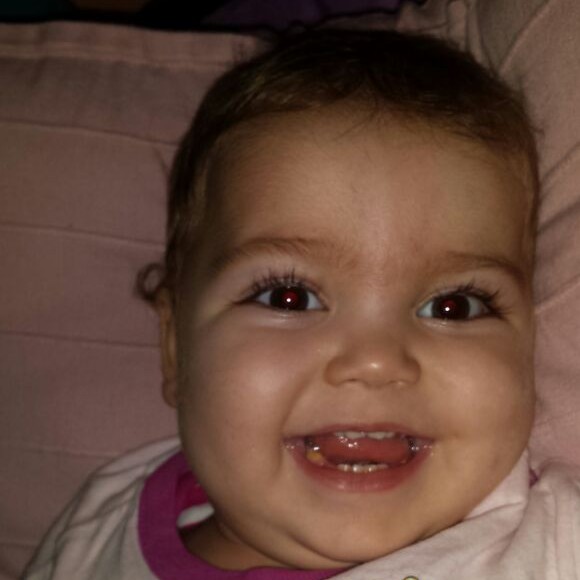
Mia’s Story
This is the story of my child, Mia.
Mia was born on 3rd March 2013 in Cremona, Italy. She was three days overdue, weighing 3.710 kg, 55 cm long born by natural birth, after normal pregnancy from a smoking mother.
At birth Mia was not very active and she underwent cardiopulmonary resuscitation, but she was not intubated. She was placed in an incubator, where she soon showed signs of perioral cyanosis, head and trunk extension, and minor trouble breathing. She was then moved into intensive care, and for about 18 hours she was given oxygen therapy and phenobarbital. She did not respond to the anticonvulsant therapy, so her doctors added topomax. By the end of March 2013 the seizures had stopped. Mia had difficulty feeding, so she was given a nasal gastric tube. When she was released from hospital on 1st May 2013, she was feeding by bottle.
Over the course of her first 18 months, Mia suffered periodic episodes of seizures and startling. Seeking the best treatment and answers, we took her to hospitals in Mantua, Genoa, and Milan. The diagnosis of KCNQ2 finally came at the end of August 2014, when Mia was nearly 18 months. Her particular genetic mutation is C.812G>A P.Gly271Asp.
This is the clinical story of my little warrior. From her mum’s point of view, on the other hand, I may say that Mia has improved a lot in time, but she is still backwards in her development: she cannot control her head, nor catch objects. She cannot speak (she only says “mamma,” “papa,” and makes sounds of lallation), and she is still fed with semi-liquid food. The great difference since her birth is that today I have got the feeling that Mia understands everything about both people and the environment around herself.
She is a smiling child, she loves playing, she can be with anybody as long as they are not wearing a doctor’s uniform.
Mia does physiotherapy four days a week. Her current medicine is topomax 2x 15 mg a day; B6 75 mg a day, Benaxol 300 mg a day, Diathynil 2×5 mg a day, Lansox 15 mg a day. She has not been given the compulsory vaccinations yet. Furthermore she often takes cortisone and antibiotics because of frequent infections in her respiratory system due to laryngo-tracheomalacia. She has never had Abingestis polmonitis, excluding a few minor apneas, detected by the check up with polysomnography. At the moment Mia’s EEG is normal.
We love so much our little girl!!
Thank you with all my heart,
Mia and family
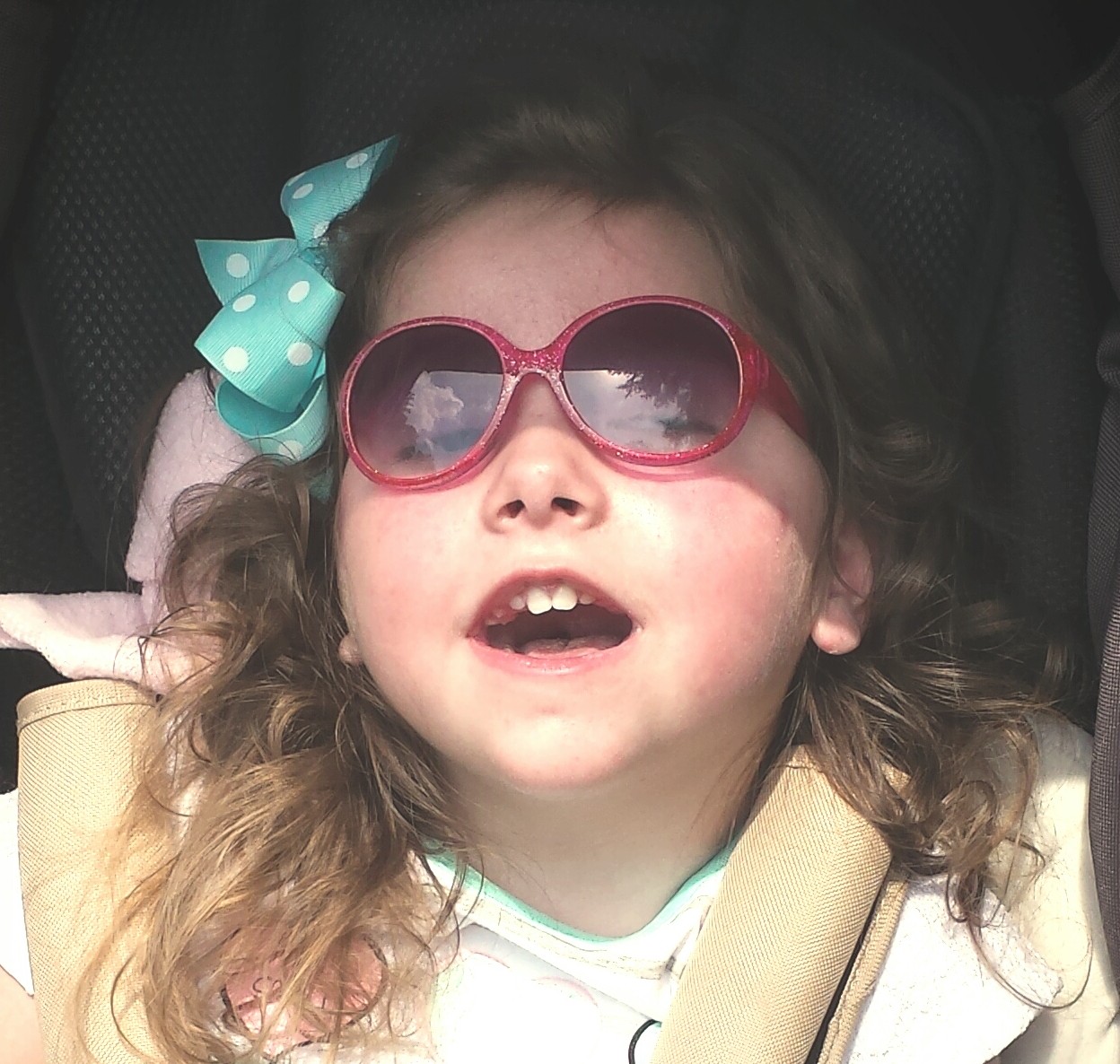
Emma’s Story
On October 5th, 2012 in the early hours of the morning our precious Emma was born at Caldwell Memorial Hospital in Lenoir, North Carolina. I had a scheduled c-section for 5 days later but she decided she was ready tocome on into this world. She weighed a healthy 7lbs 15oz and was 20 inches long.
I couldn’t see what all was going on because of having a c-section so when I didn’t hear her cry at first I got a little worried. Then after a few minutes I heard her cry and instantly felt relief. They handed her to me and she had a head full of beautiful brown hair and the cutest chubby cheeks. She was the most beautiful little girl we had ever seen. It’s hard to explain though, but when I first saw her I had this feeling that something wasn’t quite right. I don’t know why. She looked perfect and they said everything was fine. I guess it was just my mother’s intuition or something! But I just kind of kept it to myself because I thought maybe I was just nervous because I was starting over again with a newborn. My son was 11 when she was born so it
really was like starting over.
We then got back to the room and got settled and they brought her in and the nurse suggested I go ahead and try to breastfeed her. She would have trouble latching on and when she did
she would suck once or twice and then immediately fall back asleep. We tried a bunch of different ways to try and alert her but we couldn’t get her to arouse. We could get her to eat some but very little. She just kept constantly falling back asleep. The next day came and we had family and friends come to visit. Everything seemed fine except her extreme sleepiness.
That night on her second day of life the nurse took Emma into the nursery so we could get some rest and then a few hours later our life changed in a instant. I will never forget that day for the rest of my life. The nurse came in and said there is no easy way to tell you this
but your daughter had a seizure and she stopped breathing! We were in total shock to say the least. She said we are going to have to transport her to Catawba Valley Medical Center to the NICU. So they came in and explained what all was going to happen and they said they would take care of her until we could come too. We weren’t able to go with her because I had to wait for my doctor to discharge me. So we had to just wait while she left alone without us. It was so scary.
A few hours later my doctor came and discharged me so we could be with her.When we arrived she was on a breathing machine and hooked up to all these wires and tubes. Very scary sight and totally different than when we last saw her. Once minute your new baby is fine then the next minute it’s a totally different situation.. They had ran numerous tests on her. Blood
work, MRI, CT scan, spinal tap, EEG and more. All were initially normal except for the EEG. The EEG didn’t show seizures but it was abnormal from the very beginning. We stayed at that
hospital for 8 days and they couldn’t figure out what the problem was. All the tests they ran were completely normal.
So then they transferred us to a specialized Children’s Hospital. Levine’s Children’s Hospital in
Charlotte, NC. We were just hoping we would get some type of answers since she was being transferred to a more advanced bigger hospital. There it was more testing with still no answers. Emma was still very very sleepy and still had an abnormal EEG. She wasn’t still having seizures according to the EEG but we could not get her to wake up hardly at all. When she did wake up for a few moments her eye movements were uncontrollable. They would like jump around in her head and she couldn’t focus or look at anything. She also still would not wake up to eat so she had a feeding tube in her nose. One of our goals before we could leave the hospital since her seizures were under control was to have her take a bottle. Finally after a little over a month she started to wake up some to take the bottle but then she would make some forward progress with it and then she would go backwards. So she would get the tube out and then have to get it put back in. Finally after 2 1/2 months in NICU she was taking the bottle and we could head home, but still with no answers as to what caused all of this.
It was right before Christmas when we got to go home. We made it home one week before Christmas. We were all so thankful to be home for the holidays. We had tons of follow up
appointments within the next few months. We then got referred to Duke hospital when Emma was about 8 months old and they did the whole gene sequencing on Emma, my husband and I. We got the results about 3 to 4 months later that she had a de novo KCNQ2 gene mutation. We were like what?? Of course we had never heard of it and neither had the geneticist really. He had heard of maybe a couple more cases but that was it! So we still felt lost. When asked what that means for her future, what to expect next. We just heard “we really don’t know.”
So when I got home I immediately starting Googling trying to find answers. That’s when
I found a Facebook Page created for a little boy in Canada that has the same condition, Mike’s Fight. I messaged the page and they told me about the Jack’s Army and the parent Facebook page. So I joined the Facebook page and Jack’s Army and they have both been such a blessing. Finally we felt like there were actually other people out there that understood. We finally didn’t feel alone after about a year.
Emma’s seizures were sill under control but she still slept a ton and wasn’t really making any developmental progress. She then started having infantile spasms when she was about 7-8 months old. She was on numerous medications to get them under control but nothing really seemed to help her and if did help her some it would literally make her sleep for close to 24 hrs a day. She finally we think just outgrew them when she was a little over a year old but they really set her back even more than she already was. Then because of her constantly sleeping from the medications now she wasn’t able to wake up to eat so she had to get a g-tube placed a month before her first birthday. We were scared at first to do it but it has truly been a godsend for her. Without the feeding tube she may not still be with us here today.
Emma is now close to 3 years old. She is not able to sit up, walk or talk yet but we are not losing hope that some day she might! And if she doesn’t that is ok too. We just want to help her in every way that we can. She is much more awake now and her seizures are under control. She works so hard in all of her therapies every week and we are so so proud of her! Her smile is so amazing. It will make anyone’s day better and light up the whole room. We just try to take
everyday one day at a time and just give her the best care and all the love that we can. She is such a blessing to our whole family. We are all so thankful for this foundation and all of the work they are doing to find better treatment and/or a cure for all of our precious children. Thank you from the bottom of our hearts!!